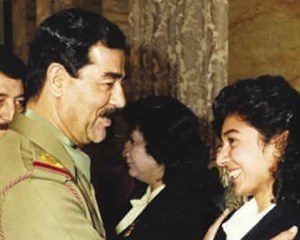Iraqi spokesman Mohammed Saeed al-Sahaf's lively press briefings claimed that Saddam was winning, but it was pretty easy to tell that his attempt to create a simulation of victory was not reality. "Baghdad is safe. The battle is still going on. Their infidels are committing suicide by the hundreds on the gates of Baghdad. Don't believe those liars," he told international camera crews on the roof of the Palestine Hotel. Behind him, viewers could see Iraqi troops fleeing from American tanks on the other side of the river. Al-Sahaf became something of a celebrity, nicknamed Comical Ali (a play on Chemical Ali, Saddam's intelligence chief Ali Hassan al-Majid, who had ordered the use of chemical weapons against the Kurds in the 1980s).
伊拉克發(fā)言人穆罕默德·賽義德·薩哈夫在生動(dòng)的新聞發(fā)布會(huì)上宣稱薩達(dá)姆即將獲勝,但不難看出,他模擬勝利的企圖是不現(xiàn)實(shí)的。“巴格達(dá)是安全的,戰(zhàn)斗仍在繼續(xù),他們的異教徒正在巴格達(dá)的大門上自殺,不要相信那些騙子,”他在巴勒斯坦酒店的屋頂上對(duì)國(guó)際攝影師們說(shuō)。在他身后,觀眾可以看到伊拉克軍隊(duì)正在河的另一邊躲避美軍的坦克。薩哈夫在某種程度上成了名人,綽號(hào)“滑稽的阿里”(“化學(xué)阿里”是薩達(dá)姆的情報(bào)主管阿里·哈桑·馬吉德的綽號(hào),他曾在20世紀(jì)80年代下令對(duì)庫(kù)爾德人使用化學(xué)武器)。
Bringing down Saddam's statue was a greater feat of hyperreality. It would be presented to the world as a climax: the triumph of Operation Iraqi Freedom. The coalition forces were cast as liberators, allowing the Iraqi people to rise up at last and tear down the most powerful symbol of the dictator who had oppressed them. But the reality was not so simple.
推翻薩達(dá)姆的雕像是超現(xiàn)實(shí)主義的偉大壯舉。它將作為高潮呈現(xiàn)給世界:伊拉克自由行動(dòng)的勝利。聯(lián)軍被塑造為解放者,最終讓伊拉克人民站起來(lái),推翻了壓迫他們的獨(dú)裁者最強(qiáng)大的象征。但現(xiàn)實(shí)并非如此簡(jiǎn)單。

Since they had invaded Iraq on 20 March, coalition forces had been pulling down dozens of statues of Saddam. For example, on 29 March, British forces had blown up a cast-iron statue of him in Basra. "The purpose of that is psychological," said a military spokesperson, "to show the people … he does not wield influence, and we will strike at any representative token of that eroding influence". But no one filmed this event, so – while it was reported by the BBC and other news organisations – it made little impact outside Basra itself.
自3月20日入侵伊拉克以來(lái),聯(lián)軍已經(jīng)推倒了幾十座薩達(dá)姆雕像。例如,3月29日,英軍在巴士拉炸毀了他的一座鑄鐵雕像。一位軍方發(fā)言人表示:“這樣做的目的是心理上的,是為了向人民表明……他沒(méi)有影響力,我們將打擊任何有代表性的削弱影響力的象征。”但是沒(méi)有人拍攝到這一事件,所以,盡管BBC和其他新聞機(jī)構(gòu)報(bào)道了這一事件,但它在巴士拉以外幾乎沒(méi)有影響。
On 7 April, the day that the fall of Baghdad began, US soldiers seized the Republican Palace. Their commander ordered his troops to find a statue that could be destroyed, and to wait until Fox News arrived before they began to destroy it. Soon enough, they found an equestrian statue of Saddam. The television crew turned up, and the soldiers duly fired a shell. The footage was not exciting – just Americans destroying stuff, no crowd of grateful Iraqis – so it did not get much play. That same day, US Marines and Iraqi civilians brought down another Saddam statue in Karbala. The next day, British troops took out another one in Basra. There were so many statues of Saddam in Iraq that they were being felled on a daily basis.
4月7日,巴格達(dá)開(kāi)始淪陷的那一天,美國(guó)士兵占領(lǐng)了共和宮。他們的指揮官命令他的部隊(duì)去尋找一個(gè)可以被摧毀的雕像,并等到福克斯新聞到達(dá)后才開(kāi)始摧毀它。很快,他們發(fā)現(xiàn)了薩達(dá)姆騎馬的雕像。電視攝制組出現(xiàn)了,士兵們適時(shí)地發(fā)射了一枚炮彈。這段錄像并不令人興奮——只有美國(guó)人在破壞東西,沒(méi)有感激涕零的伊拉克人——所以播放量并不高。同一天,美國(guó)海軍陸戰(zhàn)隊(duì)和伊拉克平民推倒了卡爾巴拉的另一座薩達(dá)姆雕像。第二天,英軍在巴士拉又推倒了一座。在伊拉克,每天都有很多薩達(dá)姆的雕像被推倒。











